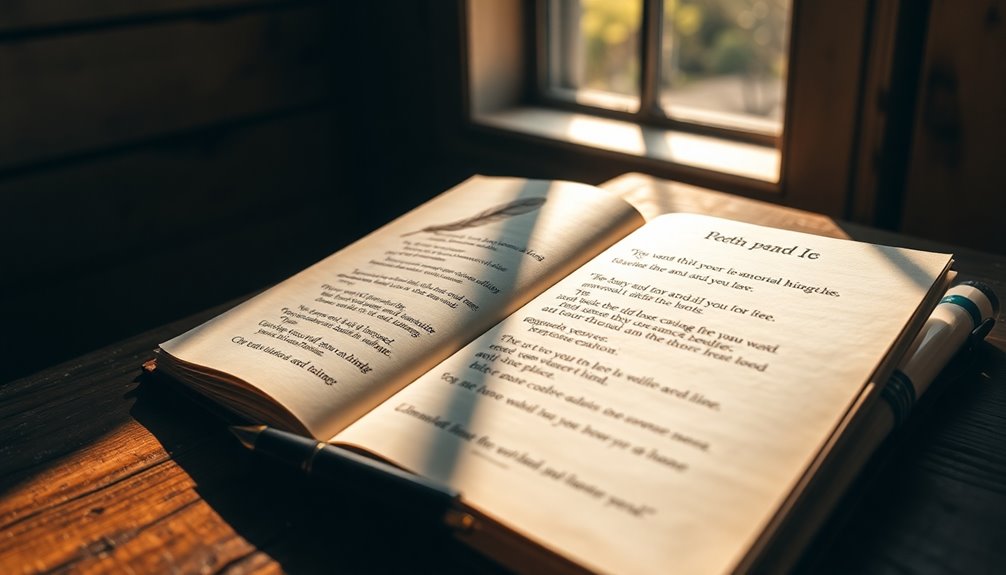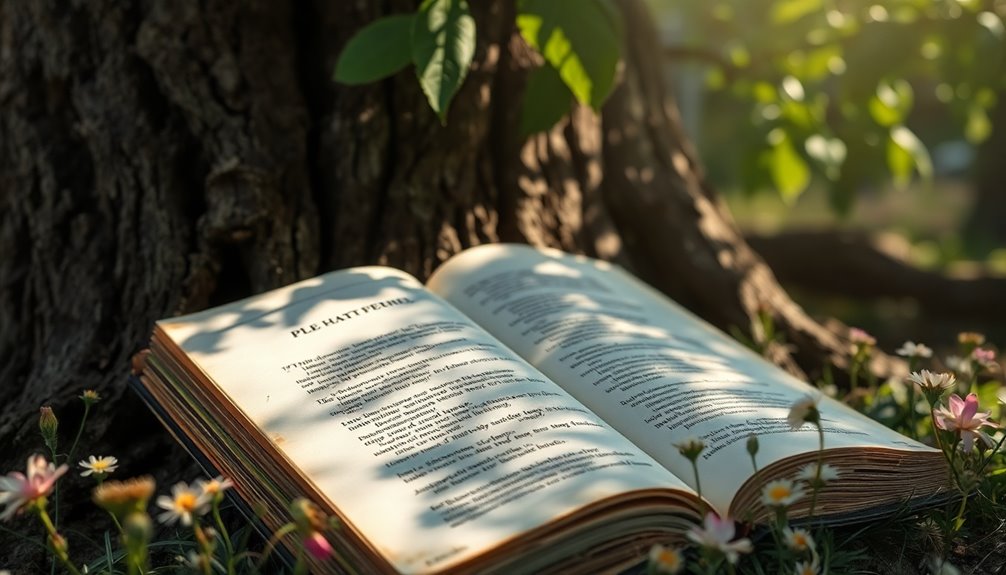Absolutely, poetry is rich with symbolism! When you explore poems, you'll notice symbols like objects, colors, or even weather that represent larger ideas. For instance, a red rose often symbolizes love, while storms might show emotional struggles. This adds layers of meaning, helping you connect more deeply to the poem. Poets like Emily Dickinson and William Wordsworth masterfully use these symbols to express feelings and convey messages. Understanding symbolism can make poetry even more enjoyable and relatable. So, if you stay curious, you'll uncover amazing insights about your favorite poems and their hidden meanings!
Key Takeaways
- Yes, poetry often employs symbolism to convey deeper meanings beyond literal interpretations.
- Symbols can represent abstract ideas, emotions, and cultural contexts, enriching the poetic experience.
- Notable poets like Wordsworth and Dickinson effectively use symbols to express universal themes.
- Nature frequently serves as a source of symbols, reflecting human emotions and societal issues.
- Understanding symbolism enhances engagement with poetry, encouraging personal reflection and critical thinking.
Understanding Symbolism in Poetry

Symbolism in poetry often enriches the text, helping you uncover deeper meanings behind the words. When you read a poem, you'll often find symbols—objects, colors, or images that stand for abstract ideas. These symbols can add layers of depth and meaning. For example, a heart might symbolize love, while a dove often represents peace. Poets use both conventional symbols, which many people recognize, and personal symbols, which reflect their own experiences.
As you investigate a poem, remember that your interpretation of these symbols might differ from someone else's. Your cultural background, personal experiences, and even the time period of the poem can influence how you understand symbolism. This makes reading poetry an exciting journey! You get to engage with multiple layers of meaning, discovering new connections to the themes presented.
Notable examples of symbolism include the raven in Edgar Allan Poe's "The Raven," which represents loss and despair, and the daffodils in William Wordsworth's poem that symbolize beauty and joy in nature.
Importance of Symbolism

The importance of symbolism in poetry lies in its ability to convey profound meanings that transcend the literal. When you read a poem, symbols can take you on a journey beyond just words. For instance, a simple rose might represent love, but it can also symbolize beauty, pain, or even secrecy. This is where the magic of symbolism in poetry shines, adding multiple layers of meaning.
Symbols evoke strong imagery and stir emotions, helping you connect deeply with the poem. You might feel joy, sadness, or nostalgia as you explore these symbols. Plus, symbolism opens the door to multiple interpretations. This invites you to think critically and reflect on what the symbols mean to you personally.
Another exciting aspect is that symbols often reflect cultural and historical contexts. They can help you understand societal issues or personal experiences in a richer way. By using symbolism, poets can express abstract concepts in just a few words, making their messages more powerful.
Notable Poets and Their Symbols

Let's explore how some famous poets use symbols to express their feelings!
For instance, William Wordsworth's rainbow stands for childish wonder and hope, reminding us of the beauty in nature.
Meanwhile, Emily Dickinson connects light with happiness and renewal in spring, showing us how nature can inspire joy and fresh beginnings.
Wordsworth's Rainbow Symbolism
Rainbows often evoke feelings of beauty and hope, and in William Wordsworth's poetry, they take on a deeper significance. For Wordsworth, the rainbow is more than a colorful arc in the sky; it's a powerful symbol of love and connection. He uses rainbows to express the joy and wonder of childhood innocence and imagination.
When you read his poems, you can feel the nostalgia, as he reminds us of the fleeting joys of youth.
Wordsworth also connects the rainbow to nature and human emotions. He believes that nature can inspire us and provide solace. The imagery of the rainbow suggests a bridge between the earthly and the divine, showing how nature reflects our inner feelings.
Each time you see a rainbow, think of it as a promise of renewal and better times ahead.
Dickinson's Light Significance**
Emily Dickinson's poetry is infused with the powerful symbolism of light, serving as a beacon of hope, happiness, and spiritual awakening. When you read her work, you'll often find light representing positive feelings, especially in nature and the changing seasons.
However, Dickinson also uses light in surprising ways. In her poem "There's a Certain Slant of Light," light takes on a different meaning. Here, it symbolizes the heavy burden of despair and deep thoughts about existence. This contrast shows how light can have both joyful and weighty aspects.
The interplay of light and darkness in her poems reflects life, death, and our search for meaning. Dickinson's light symbolism invites you to explore personal and universal themes, encouraging you to think about enlightenment and understanding.
With this recurring motif, she adds emotional depth to her poetry, creating a rich experience that engages you in a dialogue about life and the human condition. Each time you encounter light in her work, consider what it means, as you uncover the layers of her beautiful and complex symbolism.
Nature as Symbolic Representation

Nature acts as a vivid canvas for poets, transforming ordinary elements into profound symbols that reflect human emotions and experiences. You can see how nature captures feelings in the works of many poets, like William Blake, who used the beauty of nature to convey deeper meanings.
Here are some ways nature symbolizes our emotions:
- Flowers: Think of the red rose, a classic symbol of love and romance, capturing passion and connection.
- Trees: A sturdy oak can represent strength and endurance, reminding us of life's challenges.
- Weather: Storms often signify turmoil, while calm seas bring peace, helping poets express their inner feelings.
- Seasons: The passing spring, as shown in Matsuo Basho's poetry, reminds us of life's fleeting nature, encouraging us to cherish moments.
Through these symbols, poets invite you to feel and reflect on your own experiences.
Nature, with its beauty and complexity, becomes a language of its own. It helps you understand emotions in a way that words alone sometimes can't.
Social Commentary Through Symbols

When you read poetry, you might notice how symbols can shine a light on important social issues.
For example, a chimney sweeper might show the struggles of child labor, while palace walls can represent the power that keeps people down.
These symbols don't just tell stories; they make you feel and think about the world around you, sparking conversations about fairness and justice.
Symbols Reflect Societal Issues
Symbols in poetry often serve as powerful tools for social commentary, allowing poets to critique societal issues in a profound yet accessible way. You might notice that symbols reflect societal issues in many poems, making them easier to understand.
Here are some fascinating examples of symbolism that show how poets tackle big themes:
- Chimney Sweepers in William Blake's "London" symbolize child labor and oppression.
- Palace Walls represent the power and control of the monarchy, highlighting social inequalities.
- Chartered Streets and Rivers illustrate financial institutions that shape everyday life, showing capitalism's impact.
- The Thames River symbolizes the struggles faced by the marginalized, reflecting the divide between rich and poor.
Through these examples of symbolism, you can see how poets address complex themes like oppression and inequality. This makes you think about the conditions faced by different people in society.
Emotional Impact of Symbols
The emotional impact of symbols in poetry can be profound, allowing readers to connect deeply with the themes being explored. When poets use symbols, they can share important messages about society without saying them directly.
For example, in William Blake's "London," the chimney sweeps symbolize child labor, making you feel the sadness of their struggles. This imagery evokes emotional responses, stirring compassion within you as you think about their plight.
Symbols like palace walls represent the heavy weight of authority and oppression. Similarly, chartered streets and rivers show how financial institutions control lives. Each symbol encourages you to reflect on your own surroundings and the issues that matter today. You might find that these symbols spark conversations about change and awareness, inspiring you to think critically about the world.
Through symbols, poets create layers of meaning, making their work richer and more engaging. It's exciting to see how a simple image can lead to deep feelings and thoughts. Additionally, the use of symbols in poetry can mirror the positive thinking techniques found in psychological research, offering readers a pathway to personal transformation.
Critique Through Poetic Imagery
Poetic imagery serves as a powerful lens through which poets critique societal issues, often embedding their commentary within rich symbols that resonate with readers. By using symbols in their poetic imagery, poets invite you to explore deeper meanings hidden in their words.
Here are some ways they do this:
- Child Labor: In William Blake's "London," chimney sweepers stand for the harsh realities of child labor.
- Oppressive Authority: The palace walls symbolize the control and power of those in authority.
- Financial Control: Charter streets and rivers illustrate how financial institutions shape everyday life.
- Social Injustice: Poets use symbols to highlight issues like inequality and exploitation, making you think critically.
When you read poetry filled with these symbols, it sparks your emotions and encourages you to think about societal norms.
This unique way of critiquing allows you to connect with complex themes without feeling overwhelmed. Through poetic imagery, poets create a joyful experience, engaging you in important discussions about the world around you.
Analyzing Symbolism in Literature

When diving into the world of literature, you'll often find that symbols enrich the narrative and deepen the reader's experience. Analyzing symbolism is like being a detective! First, look for recurring symbols throughout the text. These symbols often hide deeper meanings that can reveal the author's intentions.
Next, consider how these symbols connect to the overall theme. For example, a storm might symbolize chaos, showing the characters' inner struggles.
Don't forget about the emotional impact! Each symbol can evoke feelings, making the story more alive. It's also important to explore the historical and cultural significance of symbols, as their meanings can change over time. Something that represents hope in one story might symbolize despair in another.
As you read, reflect on your personal associations with the symbols. This can lead to a richer understanding of the work. Remember, symbolism isn't just for poetry; it's a powerful literary device found in novels, short stories, plays, and essays.
Teaching Symbolism Effectively

Teaching symbolism effectively can transform students' understanding of poetry and enhance their critical thinking skills. When you guide your students to use symbols, they can convey complex ideas in exciting ways. Here are some fun strategies to help them grasp this important concept:
- Use Lesson Packs: Start with clear definitions and examples from well-known poems, like "I Wandered Lonely as a Cloud" by William Wordsworth. This sets a solid foundation.
- Analyze Recurring Symbols: Encourage students to identify symbols in a single poem or across multiple works. Discuss how these symbols create deeper meanings and connect to themes.
- Personal Reflection: Incorporate activities that let students explore their own associations with symbols. This personal touch boosts their engagement and understanding.
- Cultural Context: Teach them to contemplate the historical and cultural background of symbols. Knowing this context can change how they interpret a poem.
Remind your students that symbols can have multiple meanings. Encouraging openness to diverse interpretations helps foster critical thinking and analytical skills, making poetry a thrilling adventure!
Frequently Asked Questions
What Is Symbolism in Poetry?
Symbolism in poetry is when poets use symbols to represent bigger ideas or feelings.
These symbols can be anything from a simple heart for love to more unique images like a storm for trouble.
When you read a poem, you might find layers of meaning hidden in these symbols.
It's like a treasure hunt!
This makes poetry exciting and helps you connect with the emotions and experiences of others, making each poem special.
What Is Poets Symbolism?
When you think about a poet's symbolism, imagine a treasure map filled with hidden meanings!
Poets use symbols, like colors or objects, to represent big ideas and feelings. It's like a secret code that helps you connect personal experiences to larger themes.
Each symbol can mean something different to everyone, making their work even more exciting!
What Is the Symbol in the Poem?
In a poem, a symbol represents something more than its surface meaning. For example, if you see a dove, it might symbolize peace.
When you read, look for these symbols! They can show feelings or ideas that make the poem richer.
Sometimes, symbols are common, like a heart for love, while others are unique to the poet's life.
Finding these symbols can help you understand the poem's deeper message and connect with it more!
Does Poetry Always Have a Meaning?
Poetry's like a treasure chest, filled with gems of meaning. Not every poem holds a clear meaning, though.
Some poems tell simple stories or paint vivid pictures without hidden depth. You might find joy in the sound of words or the feelings they stir, even if the meaning seems unclear.
Each reader brings their own experiences, so a poem can spark different thoughts in everyone. That's the magic of poetry!
Conclusion
To summarize, poetry is like a treasure chest overflowing with symbols! Each poem sparkles with meaning just waiting for you to discover. When you plunge into the world of symbolism, you reveal deeper messages and connect with feelings that make your heart soar. So, grab your favorite poem and explore the hidden gems within! You'll find that poetry isn't just words; it's a magical journey filled with surprises. Happy reading, and may your adventures in poetry be endless!











